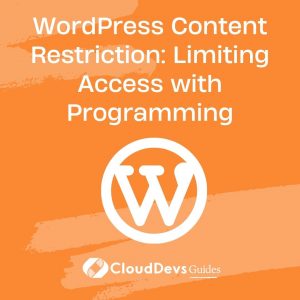WordPress Content Restriction: Limiting Access with Programming
In today’s digital landscape, security and privacy are of paramount importance. Website owners, especially those utilizing content management systems like WordPress, need to implement robust mechanisms to safeguard their content and ensure it’s accessible only to authorized users. Content restriction is a fundamental aspect of enhancing WordPress security and controlling who can view or interact with specific pieces of content. This article dives into the world of WordPress content restriction through programming techniques, equipping you with the knowledge and code samples you need to secure your website’s content effectively.
Table of Contents
1. Introduction WordPress Content Restriction
When building a website using WordPress, you might have different types of content, ranging from public blog posts to private member-only resources. It’s crucial to have the ability to restrict access to certain content based on user roles, membership levels, or other custom criteria. While there are plugins available to handle content restriction, using programming techniques gives you more flexibility and control over how you manage your content.
2. The Need for Content Restriction
2.1. Protecting Sensitive Information
Certain content on your WordPress site might contain sensitive information that you want to share only with specific users. This could include proprietary data, premium resources, or confidential documents. By restricting access, you ensure that this information doesn’t fall into the wrong hands.
2.2. Monetizing Premium Content
If you’re running a membership or subscription-based website, you’ll likely have premium content that’s accessible only to paying users. Restricting access to this content is essential for maintaining the value of your subscriptions and generating revenue.
2.3. Maintaining User Privacy
Respecting user privacy is crucial in today’s digital world. By implementing content restriction, you can ensure that users can control who has access to their personal data, interactions, and contributions on your website.
3. Implementing Content Restriction: Programming Techniques
When it comes to content restriction in WordPress, programming techniques offer a robust and customizable solution. Let’s explore some strategies and code samples for different types of content restriction scenarios.
3.1. Role-Based Content Restriction
Role-based content restriction involves limiting access to content based on the user’s role within the WordPress ecosystem. For instance, you might have content that’s only accessible to administrators, editors, or subscribers.
Code Sample: Restricting Content to Administrators
php
if ( current_user_can( 'administrator' ) ) {
// Display restricted content here
} else {
echo 'Sorry, this content is restricted.';
}
3.2. Custom User Role Content Restriction
If you’ve created custom user roles using a plugin or code, you can restrict content based on these roles as well.
Code Sample: Restricting Content to Custom User Role
php
if ( current_user_can( 'custom_role' ) ) {
// Display restricted content here
} else {
echo 'Sorry, this content is restricted.';
}
3.3. Membership Level Content Restriction
Membership-based content restriction is commonly used in websites that offer tiered access to content based on subscription levels.
Code Sample: Restricting Content to Specific Membership Level
php
if ( pmpro_hasMembershipLevel( 'gold' ) ) {
// Display restricted content here for Gold members
} else {
echo 'Sorry, this content is available to Gold members only.';
}
3.4. Password-Protected Content
You can also programmatically set content to be password-protected, allowing only users with the correct password to access it.
Code Sample: Password-Protecting Content
php
// Set the password for the content
$post_id = 123; // Replace with the actual post ID
$post = array(
'ID' => $post_id,
'post_password' => 'your_password_here'
);
wp_update_post( $post );
3.5. Restricting Content Based on User Meta
User meta contains additional information about users. You can use this information to create fine-grained content restriction rules.
Code Sample: Restricting Content Based on User Meta
php
$user_id = get_current_user_id();
$user_country = get_user_meta( $user_id, 'country', true );
if ( $user_country === 'USA' ) {
// Display content for users from the USA
} else {
echo 'Sorry, this content is restricted in your country.';
}
Conclusion
Content restriction is a vital aspect of WordPress security and privacy management. While plugins can help achieve this goal, using programming techniques gives you unparalleled control and flexibility over how you limit content access. By implementing role-based restrictions, membership-level controls, password protection, and user meta-based rules, you can create a personalized and secure browsing experience for your users. Remember that effective content restriction requires a deep understanding of WordPress functions and user roles, so take your time to learn and experiment with these techniques. This approach will undoubtedly contribute to a more secure and user-friendly WordPress website.
Table of Contents








